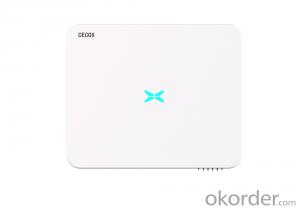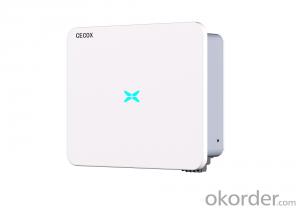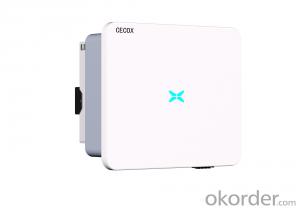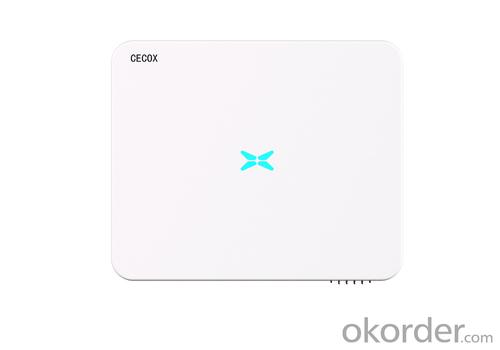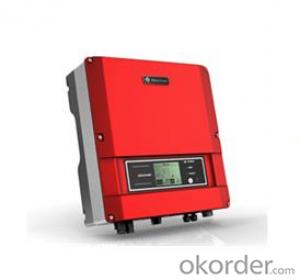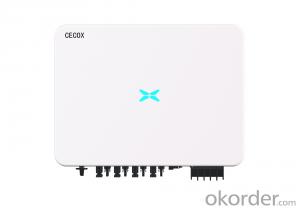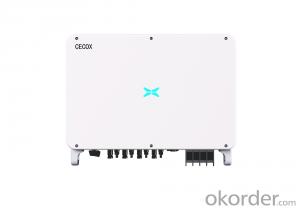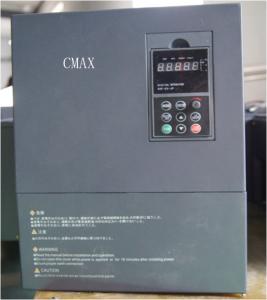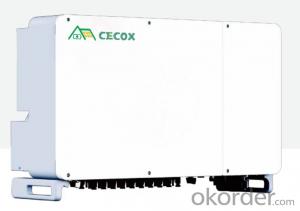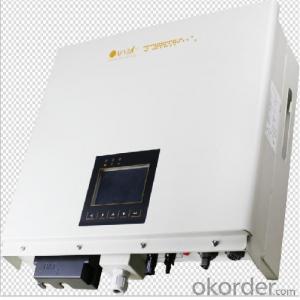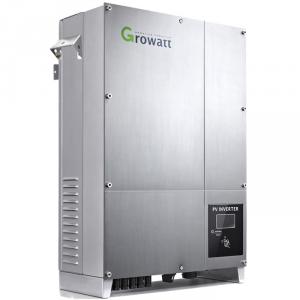17kW 20kW 22kW 25kW Three Phase On-Grid Solar Inverter
- Loading Port:
- China main port
- Payment Terms:
- TT or LC
- Min Order Qty:
- 30 unit
- Supply Capability:
- 500 unit/month
OKorder Service Pledge
OKorder Financial Service
You Might Also Like
Specification
XG17kW-25kW Three Phase On-Grid Solar Inverter
XG17KTR | XG20KTR | XG22KTR | XG25KTR | |
Input(DC) | ||||
Max. Input Power | 27.2 kW | 32kW | 35.2 kW | 40 kW |
Max. Input Voltage | 1100v | |||
Start Voltage | 250v | |||
Rated Input Voltage | 600v | |||
Full-load MPP Voltage Range | 480V~800 V | 520V~ 800V | 560V~800V | |
MPPT Voltage Range | 200 V~1000V | |||
Number of MPP Trackers | 2 | |||
Number of string per MPPT | 2/2 | 2/3 | ||
Max.Current per MPPT | 32A | 32A/48A | ||
Max.Short Circuit Current per MPPT | 40A | 40A/60A | ||
Output(AC) | ||||
Max. Output Current | 27.2A | 32.1A | 35.3A | 39.8A |
Rated Output Power | 17kW | 20kW | 22kW | 25kW |
Max. Output Power | 18.8 kVA | 22.2 kVA | 24.4kVA | 27.5kVA |
Rated Grid Frequency | 50Hz/60Hz | |||
Rated Grid Voltage | 230Vac/ 400Vac,3L/N/PE | |||
Power Factor | >0.99(0.8leading-0.8 lagging) | |||
THDi | <3%(Rated Power) | |||
Efficiency | ||||
Max. Efficiency | 98,40% | |||
European Efficiency | 98,00% | |||
MPPT Efficiency | 99,90% | |||
Protection | ||||
DC reverse polarity protection | Yes | |||
Anti-Islanding protection | Yes | |||
AC short circuit protection | Yes | |||
Residual current monitoring unit | Yes | |||
Insulation resistance monitoring | Yes | |||
Ground fault monitoring | Yes | |||
Grid monitoring | Yes | |||
PV string monitoring | Yes | |||
Surge protection | Type ll | |||
AFCI protection | Optional | |||
Communication | ||||
Display | LED/LCD /WiFi+App | |||
Communication | Standard: RS485 Optional: WiFi/GPRS/Ethernet | |||
Standard Compliance | ||||
Grid Connection Standards | IEC 61727, IEC 62116, IEC 60068, IEC 61683, VDE-AR-N 4110:2018, VDE-AR-N 4105:2018, VDE-AR-N 4120:2018, EN 50549, AS/NZS 4777.2:2020, CEI 0-21, VDE0126-1-1/A1 VFR 2014, UTE C15-712-1:2013, DEWA DRRG, NRS 097-2-1, MEA/PEA, C10/11, G98/G99 | |||
Safety/EMC | IEC 62109-1:2010, IEC 62109-2:2011, EN 61000-6-2:2005, EN 61000-6-3:2007/A1:2011 | |||
General Data | ||||
Dimensions (W*H*D) | 534x440x220 mm | |||
Weight | 24 kg | |||
Operating Temperature Range | -30° C ~ +60° C | |||
Cooling Method | Smart Cooling | |||
Protection Degree | IP66 | |||
Max. Operating Altitude | 4000 m | |||
Relative Humidity | 0~100% | |||
Topology | Transformerless | |||
Night Power Consumption | <1w | |||
MARKETING & SERVICE NETWORK
CNBM global sales team provides customers with professional and efficient pre-sale, in sale and after-sale services,
and enhances the added value of the brand with high-quality services.
Products Details:
High voltage protection Over load protection
Battery reverse connected protection Dust-proof
Low voltage protection Overheating protection
Output short-circuit protection Insect prevention
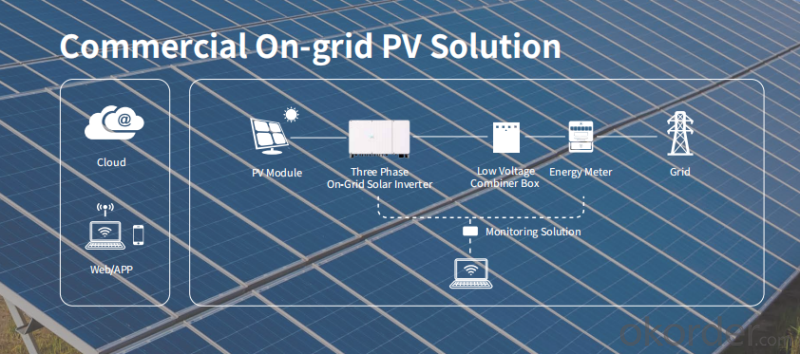

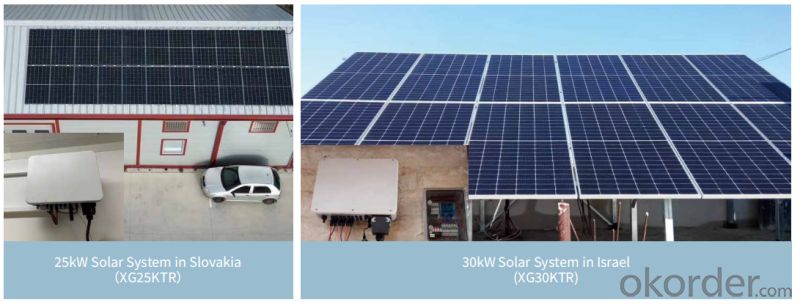

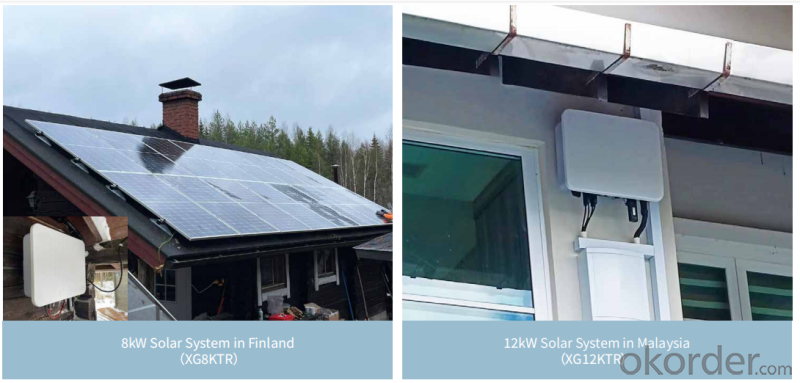
FAQ:
Q1:May I take some samples to test before placing the order ?
A1:Yes, welcome to take some sample to test!
Q2:How about the delivery time?
A2:7 days for sample; 25 days for bulk order.
Q3:What is the warranty of the controller?
A3:1 years warranty.
Q4:How to solve the technical problems?
A4:24 hours after-service consultancy just for you and to make your problem to be solved easily.
Q5:What payment methods do your company support?
A5:T/T, Western Union, Paypal, L/C etc.
Q6:What are the price terms can you offer for us?
A6:We can accept EXW, FOB, CIF and so on.
Q7:Do you have any certifications for your products?
A7:We have ISO9001:2000, CE, RoHS, certificates for all of our products.
- Q: What is the maximum number of parallel inverters that can be connected?
- The maximum number of parallel inverters that can be connected depends on various factors such as the power rating, capacity, and design of the inverters, as well as the electrical system they are being connected to. It is best to consult the manufacturer's specifications and guidelines to determine the maximum number of parallel inverters that can be safely connected.
- Q: Can a solar inverter be used with solar-powered electric fences?
- Yes, a solar inverter can be used with solar-powered electric fences. Solar inverters are commonly used to convert the direct current (DC) energy generated by solar panels into alternating current (AC) energy, which is suitable for powering electric fences. By connecting the solar panels to a solar inverter, the generated solar energy can be efficiently utilized to power the electric fence system.
- Q: Can a solar inverter be used with different AC voltages?
- Yes, a solar inverter can be used with different AC voltages. However, it is important to ensure that the inverter is compatible with the specific AC voltage and frequency requirements of the power grid it will be connected to.
- Q: How does MPPT improve the efficiency of a solar inverter?
- MPPT, or Maximum Power Point Tracking, improves the efficiency of a solar inverter by constantly adjusting the operating point of the solar panel to extract maximum power from the sunlight. It ensures that the solar panel operates at its maximum power point, regardless of changing weather conditions or variations in the solar irradiance. This optimization leads to higher energy conversion efficiency, maximizing the power output of the solar panel and ultimately increasing the overall efficiency of the solar inverter.
- Q: Can a solar inverter be used with solar-powered telecommunications systems?
- Yes, a solar inverter can be used with solar-powered telecommunications systems. A solar inverter is an essential component that converts the direct current (DC) generated by solar panels into alternating current (AC) that is required to power telecommunication equipment. This allows for efficient utilization of solar energy in telecommunications systems, making them more sustainable and independent from the grid.
- Q: Are there any government incentives or rebates available for solar inverters?
- Yes, there are government incentives and rebates available for solar inverters. These incentives and rebates vary by country and region. For example, in the United States, the federal government offers a tax credit called the Investment Tax Credit (ITC) that allows homeowners and businesses to deduct a percentage of the cost of a solar system, including inverters, from their taxes. Additionally, some states and local governments may offer their own incentives or rebates for solar inverters. It is recommended to check with local authorities or consult with a solar installer to determine the specific incentives and rebates available in a particular area.
- Q: What is the lifespan of a solar inverter?
- The lifespan of a solar inverter typically ranges from 10 to 15 years, depending on various factors such as the quality of the inverter, proper maintenance, and operating conditions.
- Q: What is the difference between a string inverter and a microinverter?
- The main difference between a string inverter and a microinverter lies in the way they convert direct current (DC) from solar panels to alternating current (AC) for use in homes or businesses. A string inverter is a centralized device that connects multiple solar panels in a series or "string" configuration. It converts the combined DC power from the entire string into AC power. This means that if one panel in the string underperforms or is shaded, it can affect the overall performance of the entire string. On the other hand, a microinverter is a small inverter that is attached to each individual solar panel. It converts the DC power from each panel into AC power independently. This allows each panel to perform optimally, even if others in the system are shaded or experiencing issues. In summary, while a string inverter handles the conversion of power from multiple panels as a whole, a microinverter ensures each panel operates at its maximum potential independently.
- Q: How does a solar inverter handle voltage fluctuations?
- A solar inverter handles voltage fluctuations by constantly monitoring the input voltage from the solar panels and adjusting its output voltage accordingly. It maintains a stable output voltage even when there are fluctuations in the input voltage, ensuring that the electricity generated by the solar panels is suitable for use in the electrical grid or for powering appliances.
- Q: Can a solar inverter be used with solar-powered data centers?
- Yes, a solar inverter can be used with solar-powered data centers. A solar inverter is the device that converts the direct current (DC) generated by solar panels into alternating current (AC) electricity that can be used to power electrical devices. By connecting a solar inverter to a solar-powered data center, the generated solar energy can be efficiently utilized to power the data center's electrical infrastructure and equipment. This helps reduce the reliance on traditional energy sources and promotes sustainability in data center operations.
Send your message to us
17kW 20kW 22kW 25kW Three Phase On-Grid Solar Inverter
- Loading Port:
- China main port
- Payment Terms:
- TT or LC
- Min Order Qty:
- 30 unit
- Supply Capability:
- 500 unit/month
OKorder Service Pledge
OKorder Financial Service
Similar products
Hot products
Hot Searches
Related keywords
